|
|
|
|
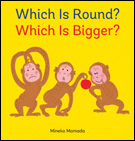
|
Which Is Round? Which Is Bigger?
by Mineko Mamada
Mamada's title with colorful illustrations for contrasting and comparing could be regarded as another simple concept book, but alas, it is not what is appears to be! Critical thinking skills are its focus as readers are encouraged to think outside the box. A duck and small peacock are portrayed on facing pages with the question of which is bigger. Of course there is the obvious answer, but what the reader sees next is the duck now compared to the peacock with its feathers fanned taking up the whole page and the answer definitely changes. What about comparing the shape of the apple to the anteater? Yes, the apple is round UNTIL it is eaten to the core and now the sleeping anteater curled up into a ball is considered round. And I love the question of which is red the apple or the watermelon, ah so simple, yet when cut in half the watermelon is now red and the apple white! Cognitive skills are fast developing at this preschool age and making unusual and multiple connections such as these are of the upmost importance. Include this title in your home or preschool library and enriching discussions are sure to follow. Recommended for children ages 3 to 6.
--Jeanne Martin, MED, Collection Development
|
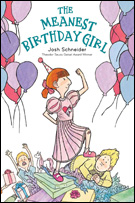
|
The Meanest Birthday Girl
by Josh Schneider
What happens when the meanest birthday girl, Dana, gets the most terrific present in the world from Anthony, the boy she’s picked on all day just because it’s her birthday? A clever plot twist reveals Anthony not as a push-over, but clever and creative indeed when he presents Dana with a magnificent, white elephant as his birthday gift. It doesn’t take long for Dana to realize her wonderful gift has gotten the best of her. In her exhausted, rumpled state, the result of caring for the beautiful elephant, she becomes the victim of another’s teasing. She begins to think and think some more and knows what she must do. Without fuss she apologizes to Anthony for pinching him, taking his desserts, and calling him names and then comes up with the “perfect gift” for the next mean birthday girl which will give rise to giggles all around. Josh Schneider’s soft, full-color, expressive illustrations are perfect for his witty tale that cleverly addresses bullying without being at all didactic. Highly recommended for early readers ages 6 to 7.
--Jeannine Wiese, BS Ed, Collection Development |
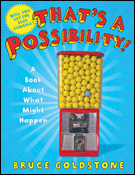
|
That's a Possibility! A Book about What Might Happen
by Bruce Goldstone
Possibilities, odds, probabilities and permutations are all covered in this appealing title full of enticing visual puzzles for readers to take part in. What flower will the bee begin to pollinate? Will it be the one yellow daisy or one of the ten pink gerbera daisies? Flip a coin six times and what are the possibilities it will land tails up? Follow the directions, make a spinner and guess the probability of it landing on a certain color, shape, number, etc. Math curriculums are built on fundamentals that children have learned with more complex concepts being added as they mature. This being said, probability is one such concept introduced at the elementary level in order to build a foundation to be enhanced and strengthened throughout the following academic years. Add this interactive title to your classroom math collection and watch the fun begin! Recommended for ages 7 to 10.
--Jeanne Martin, MED, Collection Development
|
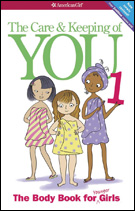
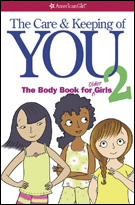
|
The Care and Keeping of You: The Body Book for Younger Girls
by Valorie Lee Schaefer with Cara Natterson, MD, medical consultant, illustrated by Josee Masse
The Care and Keeping of You 2: The Body Book for Older Girls
by Dr. Cara Natterson, illustrated by Josee Masse
Public librarians can now replace their 1998 likely high-circ, well-used, dog-eared copies of this library standard with not one but two new books! American Girl's classic The Care and Keeping of You has been revised and divided into two volumes.
The first one, The Care and Keeping of You: The Body Book for Younger Girls, is for girls 8 to 10 and is very similar to the 1998 edition with a few small and a few large exceptions.
The smaller changes are: the "Say Cheese" section has changed to "Smile and Say Calcium" to emphasize that cheese isn't the main or only source of calcium; underarm shaving tips have been moved to volume two; underwire bra discussion has been replaced with built-in bras; the "no-fail menu" is gone and in its place is a general discussion of smart eating and snacking; all of the illustrations have been redone, keeping the general appearance of the original illustrations but with crisper focus and cleaner lines.
One of the large changes is that the nutrition section has changed completely from the pyramid to the USDA's MyPlate. Another large change is that any discussion of eating disorders has been relocated to volume two. Also, the illustrated two-page section on how to insert a tampon has been replaced with how to use a pad. Using tampons is briefly addressed in a sidebar and readers are directed to volume two for a more detailed discussion. Another major revision is in the area of exercise: the amount of time to be spent aerobic exercising has increased from 20 minutes three times a week to one hour every day.
The Care and Keeping of You 2: The Body Book for Older Girls, for girls 10 to 12, addresses some of the more profound issues young girls face when going through puberty, such as proper nutrition, smart eating habits, healthy weight, positive body image, and eating disorders; emotional health and mood/stress management; family dynamics; peer pressure; and permanent body modification, which includes tanning. There are helpful labeled illustrations of the female reproductive organs, how to conduct a breast self-exam, a two-page spread for proper tampon use, and the body language displayed by young ladies with and without positive self-esteem. This book is all about empowering girls with information they need to have productive discussions about their concerns and issues with parents, trusted adults, and doctors. Girls today are inundated with many images and messages, not all of which are right for them. This book helps them make educated decisions about the choices they make during the difficult years of puberty.
I highly recommend both of these titles as new standards for public library collections.
-- Becky Walton, MLIS, Collection Development
|
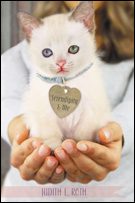
|
Serendipity and Me
by Judith L. Roth
Sara is a young lady with a big burden: she is grieving the death of her mother while her father withdraws further and further into himself, his study, and his job, leaving her to struggle through the loss by herself. Sara has wanted a cat all her life, but her father has always refused, for reasons he won't explain. Months after Sara's mother's death, an odd-eyed snow white kitten appears on their doorstep. Sara explains to her father that she needs to keep it only for a few days, while she tries to find a home for it. Of course, her real plan is to get him to fall in love with the kitten as much as she already has. Suddenly, Sara finds in little fluffy Serendipity the comfort, beauty, and love she has been craving. She has only days before her dad takes the kitten to the pound. Readers will feel Sara's longing and desperation as she struggles through each day toward the deadline; they will be attracted to the book by the sweet cover, but inside they'll find a poignant story of loss, love, and communication. Recommended for ages 10 to 13.
-- Becky Walton, MLIS, Collection Development |
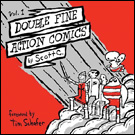
|
Double Fine Action Comics, Volume 1
by Scott C.
“And the world was made amazing,” by the uploading of this webcomic, so the publisher marketing says. Who doesn’t love a black and white, crudely-drawn comic strip with a two-headed “baby” in it? How about a knight and a strongman who are best bros? Look no further than new series Double Fine Action Comics, with two volumes publishing in April. Hilarious and easy to read, this comic will appeal to your young adult patrons. Volume 1 includes the first 300 strips. There are some pretty cool extras in the back: commentary, a how-to-draw, and other silliness. This graphic novel is recommended for ages 12 to 17.
--Jenny McCluskey, MSIS, Collection Development |
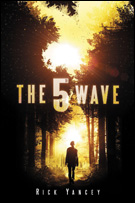
|
The 5th Wave
by Rick Yancey
1st Wave: Lights Out. 2nd Wave: Surf's Up. 3rd Wave: Pestilence. 4th Wave: Silencer. Yancey's (Monstrumologist and Alfred Kropp) new novel, The 5th Wave, opens after 99% of the world's human population has be eradicated by an alien intelligence in high-orbit over Earth. Cassie, our protagonist, is one of the astronomically lucky survivors, or perhaps unlucky, depending on how one looks at it. The narrative starts with Cassie alone, camping in the woods, to avoid roving gangs of survivors, passersby, but most of all the alien drones and the ominous Silencers. She feels like the last human alive on Earth, so she chronicles her journey, and we soon learn she doesn't believe it, because she's holding onto a scruffy, disheveled teddy bear. This bear is symbolic of a promise that she'll find her little brother, Sammy, taken by human soldiers for some unknown, dark purpose. This emotionally taut, gripping opening is then widened by other characters' POVs: the Silencer stalking Cassie in the woods, another teenage survivor, and Sammy's experiences after he's taken. This page-turner is one thrill-ride after another; Yancey constantly revs the pace despite the book's heft, and he still manages to ponder the philosophical implications of such an event occurring through Cassie's astringent narration. Diverse audiences will love this series opener, adult and YA, so you might want to acquire a few extra copies! Recommended for ages 13 and up.
--Jill M. Barton, MLIS, Collection Development
|
| |
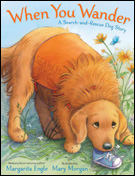
|
When You Wander: A Search-and-Rescue Dog Story
by Margarita Engle, illustrated by Mary Morgan
“If you are lost, / stay in one place. / Hug a tree. / Think of me. / I will race / against the night / and the wind / to bring you home / safe.” Normally known for her young adult fiction or poetry books, Engle has created her second picture book for children. Based on her own knowledge of helping her husband train his wilderness search-and-rescue dogs, she has crafted a sweet story helping young children know what to do if they are lost outdoors. Told from the point of view of the dog, this less threatening approach will enforce the points of finding one spot and staying there while help is on the way. Concluding with facts about the dog nose, even as a long time dog owner I had no clue the left and right nostrils sniffed separately which helps the dog follow the direction of the scent trail, and advice for parents and teachers, this title definitely stands out. Illustrations created with watercolor, gouache, and colored pencils by Morgan are soft and sweet, reinforcing the idea that if the child does exactly this, a happy ending will result. Highly recommended for ages 4 to 7.
--Tracy Gallagher, MLIS, Collection Development |
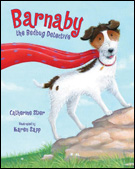
|
Barnaby the Bedbug Detective
by Catherine Stier, illustrated by Karen Sapp
While I can immediately think of many jobs held by dogs: bomb sniffing, service helper, search-and-rescue, even herding, I will admit being a bedbug detective dog was new to me. In this happy ending to living the “shelter dog life” picture book, high-energy Barnaby is rescued from an animal pound and given the chance to help others by being trained to identify when and where bedbugs exist. What a wonderful way to help shelter dogs move on to productive lives! Stier gives special thanks to the original bedbug-sniffing dog she met named Bernie. With additional information at the end on what bedbugs are, how to prevent bedbugs from invading your home, and a bibliography of other titles, interested children will have an opportunity to learn more (and enjoy a bit of the ick factor as well). Sapp’s illustrations, created in acrylic, are colorful and heartwarming. Recommended for ages 5 to 8.
--Tracy Gallagher, MLIS, Collection Development |

|
War Dogs: Churchill and Rufus
by Kathryn Selbert
Selbert gives young readers a cursory introduction to British Prime Minister Winston Churchill during the World War II years, using his relationship with his miniature poodle Rufus to convey Churchill’s quiet but “bulldog” leadership and love of country. Quotations from Churchill appear on each two-page spread to complement the narrative. The illustrations convey the tone of events described on the page, from the bucolic setting in the countryside to the Blitz; one striking two-page illustration incorporates Herbert Mason’s famous photo taken on 12/29/40 of St. Paul’s Cathedral standing tall amid the bombed ruins of London. Teachers will appreciate that this picture book story is followed by abundant background material: a two-page timeline of World War II, a discussion of Churchill and his affection for poodles, a brief biography of the Prime Minister, a bibliography, and quotation sources. Recommended for ages 7 to 10.
-- Becky Walton, MLIS, Collection Development
|

|
Dogs on Duty: Soldiers' Best Friends on the Battlefield and Beyond Hardcover and Library Binding
by Dorothy Hinshaw Patent
Dogs have been used by the U.S. military since World War I. Patent begins the story with some of the variety of tasks that military dogs can carry out and what traits dogs possess that make them ideal for working with our armed forces. After the Vietnam War, the U.S. military realized more deeply what a valuable resource the dog was and in 1972 established a working dog training center at the Lackland Air Force Base in Texas, which focuses on raising and training a particular breed: the Belgian Malinois. Readers learn how a puppy begins his training (as early as three days old!), what the training experience is like, and what missions graduate dogs may be assigned. Scattered liberally throughout are gorgeous photos of dogs in action and profiles of some famous military dogs. This is a crowd pleaser for ages 8 to 11.
-- Becky Walton, MLIS, Collection Development
|
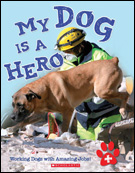
|
My Dog Is a Hero
by Anita Ganeri
This gorgeous book is a delight for dog lovers. Ganeri arranges her discussion of working dogs into five categories: lifesavers, protectors, helper dogs, detectors, and explorers. For each type of work, the author explains which breeds are best suited for that work: the Newfoundland's webbed feet and rudder-like tail make it great for water rescue; the Labrador Retriever's loyalty and trainability make it a good choice for a guide dog; and the Alaskan Malamute's double coat, wide paws, and strong heart are perfect for Arctic exploration. Profiles, quotes, and pictures of hero dogs and their owners appear throughout the book. Who can resist a book with a picture of a German Shepherd in a vertical climb up a ladder or an owner kissing the pitbull who shielded a member of the family from flames until the fire department arrived. This is a great book for animal lovers and the short sections and striking photographs make it also an ideal recommendation for reluctant readers. Recommended for ages 8 to 11.
-- Becky Walton, MLIS, Collection Development |

|
Mush: Sled Dogs of the Iditarod
by Joe Funk
Funk begins this thrilling exploration of Iditarod sled dogs with a profile of Dallas Seavey, the winner of the 2012 race, and his two lead dogs, Guiness and Diesel. Next comes a discussion of how the Siberian Husky was introduced to Alaska and how the breed physically differs from the Alaskan Malamute. Of course, no story of Alaskan dogs would be complete with talking about Balto, and we are given the story of the hard-working dog who led the team to get diphtheria medicine to Nome. Funk also explains how dogsled team racing got its start and what equipment is needed, both for the humans and the dogs. Finally, there are profiles of five famous sled dogs. Readers will be captivated by the photographs: many pages come alive with color pictures of sled dogs who seem to be laughing wildly at the joy they are feeling, either running a race or basking in the sun. Readers ages 9 to 12 will want a mug of hot cocoa after reading this cool book!
-- Becky Walton, MLIS, Collection Development |
|



